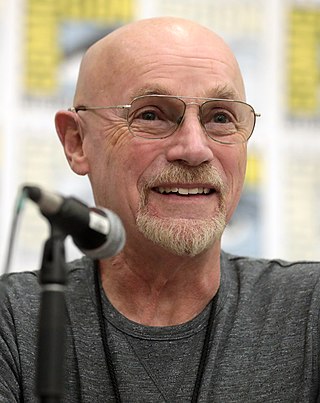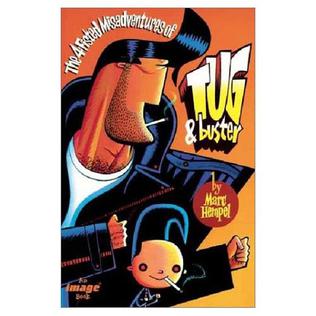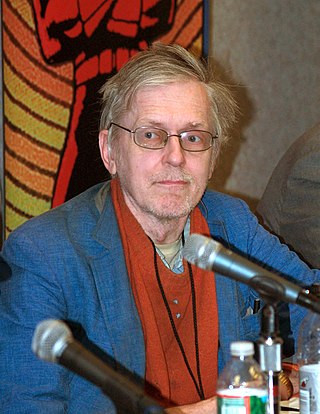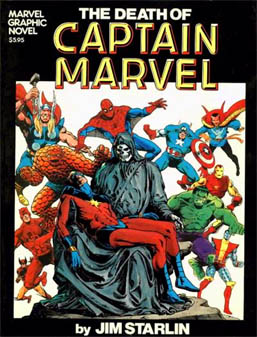
Christopher S. Claremont is an American comic book writer and novelist, known for his 16-year stint on Uncanny X-Men from 1975 to 1991, far longer than that of any other writer, during which he is credited with developing strong female characters as well as introducing complex literary themes into superhero narratives, turning the once underachieving comic into one of Marvel's most popular series.

Mark Stephen Evanier is an American comic book and television writer, known for his work on the animated TV series Garfield and Friends and on the comic book Groo the Wanderer. He is also known for his columns and blog News from ME, and for his work as a historian and biographer of the comics industry, such as his award-winning Jack Kirby biography, Kirby: King of Comics.

James P. Starlin is an American comics artist and writer. Beginning his career in the early 1970s, he is best known for space opera stories, for revamping the Marvel Comics characters Captain Marvel and Adam Warlock, and for creating or co-creating the Marvel characters Thanos, Drax the Destroyer, Gamora, Nebula, and Shang-Chi, as well as writing the acclaimed miniseries The Infinity Gauntlet and its many sequels, namely The Infinity War and The Infinity Crusade, all detailing Thanos' pursuit of the Infinity Gems to court Mistress Death by annihilating half of all life in the cosmos, before coming into conflict with the Avengers, X-Men, Fantastic Four, the Elders of the Universe, joined by Silver Surfer, Doctor Strange, Gamora, Nebula, and Drax.

Tony Isabella is an American comic book writer, editor, actor, artist and critic, known as the creator and writer of Marvel Comics' Black Goliath; DC Comics' first major African-American superhero, Black Lightning; and as a columnist and critic for the Comics Buyer's Guide.

Comics Buyer's Guide, established in 1971, was the longest-running English-language periodical reporting on the American comic book industry. It awarded its annual Comics Buyer's Guide Fan Awards from 1983 to circa 2010. The publication ceased with the March 2013 issue. The magazine was headquartered in Iola, Wisconsin, after originally being published in the Quad Cities region.

Nelson Alexander Ross is an American comic book writer and artist known primarily for his painted interiors, covers, and design work. He first became known with the 1994 miniseries Marvels, on which he collaborated with writer Kurt Busiek for Marvel Comics. He has since done a variety of projects for both Marvel and DC Comics, such as the 1996 miniseries Kingdom Come, which Ross co-wrote. Since then he has done covers and character designs for Busiek's series Astro City, and various projects for Dynamite Entertainment. His feature film work includes concept and narrative art for Spider-Man and Spider-Man 2, and DVD packaging art for the M. Night Shyamalan film Unbreakable. He has done covers for TV Guide, promotional artwork for the Academy Awards, posters and packaging design for video games, and his renditions of superheroes have been merchandised as action figures.

Stephen Ross Gerber was an American comic book writer and creator of the satiric Marvel Comics character Howard the Duck. Other works include Man-Thing, Omega the Unknown,Marvel Spotlight: "Son of Satan", The Defenders,Marvel Presents: "Guardians of the Galaxy", Daredevil and Foolkiller. Gerber often included lengthy text pages in the midst of comic book stories, such as in his graphic novel, Stewart the Rat. Gerber was posthumously inducted into the Will Eisner Comic Book Hall of Fame in 2010.

Marc Hempel is an American cartoonist/comics artist best known for his work on The Sandman with Neil Gaiman.

Paul Gulacy is an American comics artist best known for his work for DC Comics and Marvel Comics, and for drawing one of the first graphic novels, Eclipse Enterprises' 1978 Sabre: Slow Fade of an Endangered Species, with writer Don McGregor. He is most associated with Marvel's 1970s martial-arts and espionage series Master of Kung Fu.

Alien Legion is a science-fiction comic-book series and associated titles created by Carl Potts, Alan Zelenetz, and Frank Cirocco for Marvel Comics's Epic Comics imprint in 1983. It features a military unit, Force Nomad, similar to the French Foreign Legion.
Steven Grant is an American comic book writer best known for his 1985–1986 Marvel Comics mini-series The Punisher with artist Mike Zeck and for his creator-owned character Whisper.

Peter Sanderson Jr. is a comic book critic and historian, as well as an instructor/lecturer in the New York area concerning the study of graphic novels/comic books as literature.

Ken Steacy is a Canadian comics artist and writer best known for his work on the NOW Comics comic book series of Astro Boy and of the Comico comic series of Jonny Quest, as well as his graphic novel collaborations with Harlan Ellison and Dean Motter. Steacy was a member of the Royal Canadian Air Cadets 386 Comox Squadron.
Phil Winslade is a British comic book artist.

Robert Ingersoll is an American lawyer and writer. Ingersoll's full-time occupation was an appellate attorney with the Cuyahoga County Public Defender Office in Cleveland, Ohio, until he retired in 2009. He is more widely known for his writing, in particular his work in comic books.
This article lists major events in the field of comics during the 1980s.

Marvel Graphic Novel (MGN) is a line of graphic novel trade paperbacks published from 1982 to 1993 by Marvel Comics. The books were published in an oversized format, 8.5" x 11", similar to French albums. In response, DC Comics established a competitor line known as DC Graphic Novel.
John Costanza is an American comic book artist and letterer. He has worked for both DC Comics and Marvel Comics. He was the letterer during Alan Moore's acclaimed run on Swamp Thing. The bulk of Costanza's art assignments have been for anthropomorphic animal comics and children-oriented material.
Epic Comics was an imprint of Marvel Comics from 1982 to 1996. A spin-off of the publisher's Epic Illustrated magazine, it published creator-owned work unconnected to Marvel's superhero universe, and without the restrictions of the Comics Code. The name was revived by Marvel in the mid-2000s for a short-lived program inviting new writers to pitch series proposals to the publisher.














